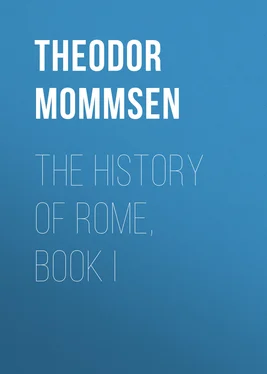Theodor Mommsen - The History of Rome, Book I
Здесь есть возможность читать онлайн «Theodor Mommsen - The History of Rome, Book I» — ознакомительный отрывок электронной книги совершенно бесплатно, а после прочтения отрывка купить полную версию. В некоторых случаях можно слушать аудио, скачать через торрент в формате fb2 и присутствует краткое содержание. Жанр: foreign_prose, История, foreign_edu, foreign_antique, на английском языке. Описание произведения, (предисловие) а так же отзывы посетителей доступны на портале библиотеки ЛибКат.
- Название:The History of Rome, Book I
- Автор:
- Жанр:
- Год:неизвестен
- ISBN:нет данных
- Рейтинг книги:5 / 5. Голосов: 1
-
Избранное:Добавить в избранное
- Отзывы:
-
Ваша оценка:
- 100
- 1
- 2
- 3
- 4
- 5
The History of Rome, Book I: краткое содержание, описание и аннотация
Предлагаем к чтению аннотацию, описание, краткое содержание или предисловие (зависит от того, что написал сам автор книги «The History of Rome, Book I»). Если вы не нашли необходимую информацию о книге — напишите в комментариях, мы постараемся отыскать её.
The History of Rome, Book I — читать онлайн ознакомительный отрывок
Ниже представлен текст книги, разбитый по страницам. Система сохранения места последней прочитанной страницы, позволяет с удобством читать онлайн бесплатно книгу «The History of Rome, Book I», без необходимости каждый раз заново искать на чём Вы остановились. Поставьте закладку, и сможете в любой момент перейти на страницу, на которой закончили чтение.
Интервал:
Закладка:
All these indications, which even in themselves are of great weight, become more significant when we recollect that the accurately known circuit of the Palatine city of the Seven Mounts excluded the Quirinal, and that afterwards in the Servian Rome, while the first three regions corresponded to the former Palatine city, a fourth region was formed out of the Quirinal along with the neighbouring Viminal. Thus, too, we discover an explanation of the reason why the strong outwork of the Subura was constructed beyond the city wall in the valley between the Esquiline and Quirinal; it was at that point, in fact, that the two territories came into contact, and the Palatine Romans, after having taken possession of the low ground, were under the necessity of constructing a stronghold for protection against those of the Quirinal.
Lastly, even the name has not been lost by which the men of the Quirinal distinguished themselves from their Palatine neighbours. As the Palatine city took the name of "the Seven Mounts," its citizens called themselves the "mount-men" (-montani-), and the term "mount," while applied to the other heights belonging to the city, was above all associated with the Palatine; so the Quirinal height—although not lower, but on the contrary somewhat higher, than the former—as well as the adjacent Viminal never in the strict use of the language received any other name than "hill" (collis). In the ritual records, indeed, the Quirinal was not unfrequently designated as the "hill" without further addition. In like manner the gate leading out from this height was usually called the "hill-gate" (-porta collina-); the priests of Mars settled there were called those "of the hill" (-Salii collini-) in contrast to those of the Palatium (-Salii Palatini-) and the fourth Servian region formed out of this district was termed the hill-region (-tribus collina-) 25 25 Although the name "Hill of Quirinus" was afterwards ordinarily used to designate the height where the Hill-Romans had their abode, we need not at all on that account regard the name "Quirites" as having been originally reserved for the burgesses on the Quirinal. For, as has been shown, all the earliest indications point, as regards these, to the name -Collini-; while it is indisputably certain that the name Quirites denoted from the first, as well as subsequently, simply the full burgess, and had no connection with the distinction between montani and collini (comp. chap. v. infra). The later designation of the Quirinal rests on the circumstance that, while the -Mars quirinus-, the spear-bearing god of Death, was originally worshipped as well on the Palatine as on the Quirinal—as indeed the oldest inscriptions found at what was afterwards called the Temple of Quirinus designate this divinity simply as Mars,—at a later period for the sake of distinction the god of the Mount-Romans more especially was called Mars, the god of the Hill Romans more especially Quirinus. When the Quirinal is called -collis agonalis-, "hill of sacrifice," it is so designated merely as the centre of the religious rites of the Hill-Romans.
The name of Romans primarily associated with the locality was probably appropriated by these "Hill-men" as well as by those of the "Mounts;" and the former perhaps designated themselves as "Romans of the Hill" (-Romani collini-). That a diversity of race may have lain at the foundation of this distinction between the two neighbouring cities is possible; but evidence sufficient to warrant our pronouncing a community established on Latin soil to be of alien lineage is, in the case of the Quirinal community, totally wanting. 26 26 The evidence alleged for this (comp. e. g. Schwegler, S. G. i. 480) mainly rests on an etymologico-historical hypothesis started by Varro and as usual unanimously echoed by later writers, that the Latin -quiris- and -quirinus- are akin to the name of the Sabine town -Cures-, and that the Quirinal hill accordingly had been peopled from -Cures-. Even if the linguistic affinity of these words were more assured, there would be little warrant for deducing from it such a historical inference. That the old sanctuaries on this eminence (where, besides, there was also a "Collis Latiaris") were Sabine, has been asserted, but has not been proved. Mars quirinus, Sol, Salus, Flora, Semo Sancus or Deus fidius were doubtless Sabine, but they were also Latin, divinities, formed evidently during the epoch when Latins and Sabines still lived undivided. If a name like that of Semo Sancus (which moreover occurs in connection with the Tiber-island) is especially associated with the sacred places of the Quirinal which afterwards diminished in its importance (comp. the Porta Sanqualis deriving its name therefrom), every unbiassed inquirer will recognize in such a circumstance only a proof of the high antiquity of that worship, not a proof of its derivation from a neighbouring land. In so speaking we do not mean to deny that it is possible that old distinctions of race may have co-operated in producing this state of things; but if such was the case, they have, so far as we are concerned, totally disappeared, and the views current among our contemporaries as to the Sabine element in the constitution of Rome are only fitted seriously to warn us against such baseless speculations leading to no result.
Relations between the Palatine and Quirinal Communities
Thus the site of the Roman commonwealth was still at this period occupied by the Mount-Romans of the Palatine and the Hill-Romans of the Quirinal as two separate communities confronting each other and doubtless in many respects at feud, in some degree resembling the Montigiani and the Trasteverini in modern Rome. That the community of the Seven Mounts early attained a great preponderance over that of the Quirinal may with certainty be inferred both from the greater extent of its newer portions and suburbs, and from the position of inferiority in which the former Hill-Romans were obliged to acquiesce under the later Servian arrangement. But even within the Palatine city there was hardly a true and complete amalgamation of the different constituent elements of the settlement. We have already mentioned how the Subura and the Palatine annually contended for the horse's head; the several Mounts also, and even the several curies (there was as yet no common hearth for the city, but the various hearths of the curies subsisted side by side, although in the same locality) probably felt themselves to be as yet more separated than united; and Rome as a whole was probably rather an aggregate of urban settlements than a single city. It appears from many indications that the houses of the old and powerful families were constructed somewhat after the manner of fortresses and were rendered capable of defence—a precaution, it may be presumed, not unnecessary. It was the magnificent structure ascribed to king Servius Tullius that first surrounded not merely those two cities of the Palatine and Quirinal, but also the heights of the Capitol and the Aventine which were not comprehended within their enclosure, with a single great ring-wall, and thereby created the new Rome—the Rome of history. But ere this mighty work was undertaken, the relations of Rome to the surrounding country had beyond doubt undergone a complete revolution. As the period, during which the husbandman guided his plough on the seven hills of Rome just as on the other hills of Latium, and the usually unoccupied places of refuge on particular summits alone presented the germs of a more permanent settlement, corresponds to the earliest epoch of the Latin stock without trace of traffic or achievement; as thereafter the flourishing settlement on the Palatine and in the "Seven Rings" was coincident with the occupation of the mouths of the Tiber by the Roman community, and with the progress of the Latins to a more stirring and freer intercourse, to an urban civilization in Rome more especially, and perhaps also to a more consolidated political union in the individual states as well as in the confederacy; so the Servian wall, which was the foundation of a single great city, was connected with the epoch at which the city of Rome was able to contend for, and at length to achieve, the sovereignty of the Latin league.
Читать дальшеИнтервал:
Закладка:
Похожие книги на «The History of Rome, Book I»
Представляем Вашему вниманию похожие книги на «The History of Rome, Book I» списком для выбора. Мы отобрали схожую по названию и смыслу литературу в надежде предоставить читателям больше вариантов отыскать новые, интересные, ещё непрочитанные произведения.
Обсуждение, отзывы о книге «The History of Rome, Book I» и просто собственные мнения читателей. Оставьте ваши комментарии, напишите, что Вы думаете о произведении, его смысле или главных героях. Укажите что конкретно понравилось, а что нет, и почему Вы так считаете.











